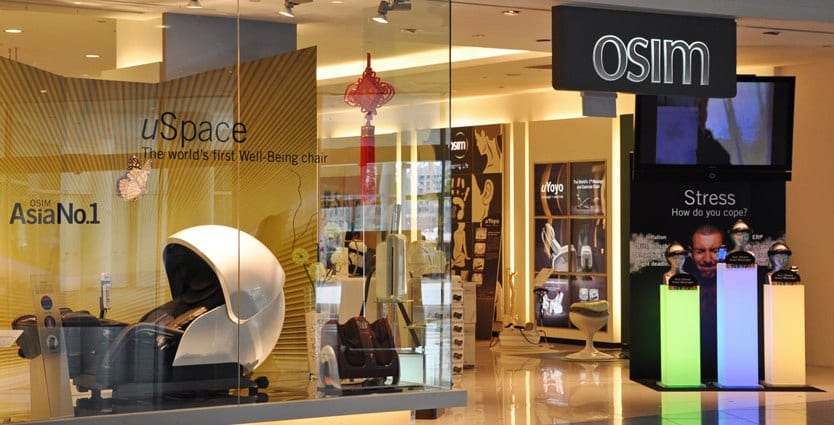
OSIM International (SGX: O23) has been in the news recently due to CEO Ron Sim’s offer to privatize the company at $1.32 a share — which he later raised to $1.39 and then $1.41. In my previous article, I made the argument that OSIM is currently undervalued and is worth at least $1.47 a share. With that in mind, I decided to attend OSIM’s FY2015 AGM to gain some insight into the company and Ron Sim’s plans moving forward.
Here are six things I learned from OSIM’s FY2015 AGM:
1. Drop in revenue is due to business cycles
Ron Sim mentioned that post Lehman Brother crisis, OSIM has been achieving double-digit growth for 22 quarters. In the second half of 2014, the market experienced a slowdown which caused OSIM’s growth to decline. Sim feels that conditions are tough right now in Singapore and Malaysia. He added that Singapore has been on a good run the last 10 years and it is time for a correction.
Having been in business for 37 years, Sim is a firm believer of business cycles. He believes that every six to eight years the market will shift and one cannot entirely escape from the turn in cycles. What is more important is for OSIM to deal with the down-cycle and find ways to sustain its business without brand dilution while maintaining its margins, healthy cash flows, and a strong cash position.
2. Profit fell 50% in FY2015 due to three factors
The drop in net profit was cause by three factors:
- One-off provision of legal fees of $10.1 million due to the TWG Tea lawsuit
- The deconsolidation of Oni Australia which cost $5.6 million
- The expansion of TWG Tea; the business opened 15 stores in 2015 alone. While sales figures increased, it doesn’t mean that profit rose in tandem as well. TWG Tea Singapore took nine years to be profitable due to its high cost. Hence, TWG Tea is actually a drag to OSIM’s profit.
Despite the tough conditions, OSIM has managed to maintain its gross margins. Ron Sim mentioned there are two ways to grow the business: You either sacrifice sales or margins. If you want more sales, OSIM can sell more of their products at a discount but at the expense of margins. OSIM is careful about its margins because it has three different retail brands with multiple stores in multiple countries; there are many operational costs that can’t be cut.
3. OSIM is miles ahead of its competition
During the AGM, Ron Sim proudly declared that OSIM is miles ahead of its competition because the company always invests the time and resources to plan two to three years ahead which is why you see OSIM launching new consumer products every quarter. But Sim cautioned that in times of weak market conditions OSIM cannot spend indiscriminately on advertising for its new products because it’ll be akin to ‘shooting at no targets’. He added that the company must be mindful of how it spends its money during tough times.
4. OSIM acquired TWG TEA because if its strong branding position
In 2011, OSIM acquired a 35% stake in TWG Tea for $70 million even though the business was making $2 million in annual loss. Ron Sim saw that TWG Tea had built a strong brand in the market. Since the acquisition, TWG Tea has leveraged on its luxury brand appeal and grown from three outlets to 52 outlets in just six years.
5. OSIM doesn’t want to reveal its revenue by retail segment
If you read OSIM’s annual report, you will realize that it classifies OSIM, Oni Global, and TWG Tea under one single category called Retail. It does not break down how much each segment individually contributes to OSIM’s total revenue. Ron Sim feels that Oni Global and TWG Tea are still not sizable enough (especially TWG Tea which is still in the early stages of growth) to be categorized separately. Sim further mentioned that the management prefers not to reveal too many details about TWG Tea for competitive reasons. Moving forward, OSIM will only segmentize its retail revenue when Oni Global and TWG Tea are larger.
6. Ron Sim feels his offer is fair to shareholders
During the 2008-2009 crisis, OSIM’s share price plunged to 5.5 cents. At that point in time, three banks approached Ron Sim to delist the company. He said that he could have taken OSIM private at eight cents per share which would have cost him only less than $20 million, but he chose not to do it. The reason was he had been in business for a long time and he did not want to spoil his reputation. OSIM had around 3,000 shareholders then and he wanted to be fair to them. So he issued rights and started to rebuild OSIM again, eventually bringing its share price from 5.5 cents to a high of $2.90. He believes he has done his job as the driver of the company.
As fair as Sim wants to be, he said that stock prices are driven by market sentiment which he has no control over. He believes his offer price is fair for investors relative to the value of the company. Sim reasons that privatization is the better option for OSIM, so it can run its business without hindrance from public-listed company regulations and protocol.




good summary. personally, I feel what mr sim says are all very reasonable points. but also that he is not revealing what he is truly thinking about the osim privatisation. only he knows.
Even if you climb to the highest mountain, you can only take a step on the ground